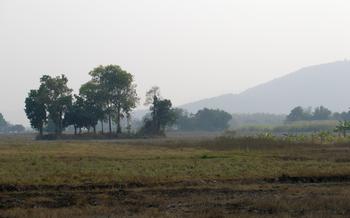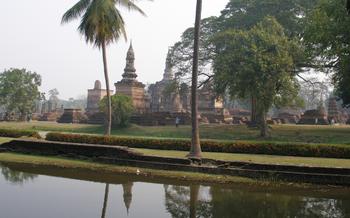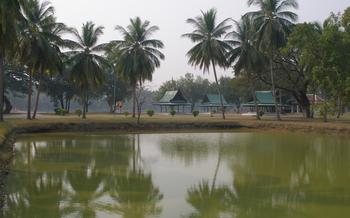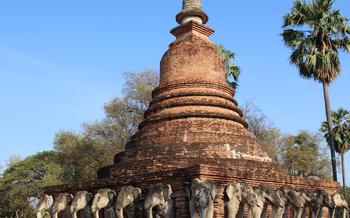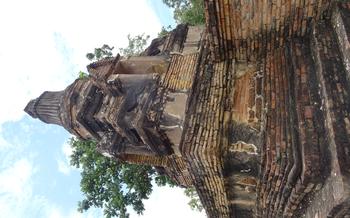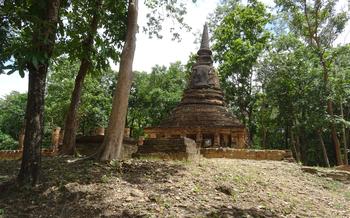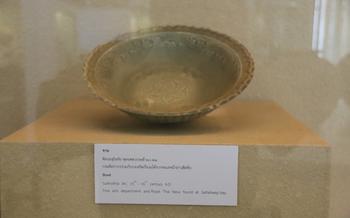
Wat Si Chum
- Historical Significance
- Unique Features
- Exploring the Temple Grounds
- Experiencing Local Culture
- Transportation and Accessibility
- Dress Code and Etiquette
- Photography Tips: Capturing the Essence of Wat Si Chum
- Guided Tours
- Nearby Attractions:
- Budget Tips
- Safety Precautions
- Responsible Tourism
- Historical Context
- Insider Tip: Unveiling the Hidden Beauty of Wat Si Chum
Historical Significance
Sukhothai, the ancient capital of Thailand, holds a rich history that can be explored through its numerous temples and ruins. Among these, Wat Si Chum stands out as a remarkable testament to the grandeur of the Sukhothai Kingdom. Built in the 13th century, this temple served as a religious and cultural center, embodying the essence of Thai Buddhism during its golden age. Its architectural and artistic features reflect the intricate craftsmanship and deep spiritual beliefs of the Sukhothai people, making it a must-visit destination for anyone interested in Thai history and culture.
Wat Si Chum played a pivotal role in the propagation of Theravada Buddhism throughout the Sukhothai Kingdom. It was a place of worship, learning, and meditation for monks and laypeople alike. The temple's design and iconography were meticulously crafted to inspire devotion and teach Buddhist principles. Its stunning Buddha statue, Phra Achana, is a masterpiece of Sukhothai art and a symbol of the kingdom's religious and cultural heritage.
Wat Si Chum's historical significance extends beyond its religious function. It served as a symbol of the Sukhothai Kingdom's power and prestige, attracting pilgrims and visitors from far and wide. The temple's architectural style influenced subsequent periods of Thai architecture, leaving a lasting legacy on the country's artistic traditions. By exploring Wat Si Chum, visitors can gain a deeper understanding of the Sukhothai Kingdom's profound impact on Thai culture and history.
Unique Features
Wat Si Chum is renowned for its remarkable Buddha statue, known as Phra Achana. This colossal sandstone figure stands at an impressive 15 meters tall, making it one of the largest Buddha images in Thailand. The statue's unusual position, reclining on its right side, is a distinctive feature that sets it apart from other Buddha statues in the country. This posture, known as the "sleeping Buddha," symbolizes the Buddha's imminent passing into nirvana, the ultimate state of liberation from suffering.
The intricately carved stucco decorations and murals that adorn the temple's walls are another highlight of Wat Si Chum. These exquisite artworks depict scenes from the Buddha's life and teachings, as well as mythical creatures and celestial beings. The attention to detail and the vibrant colors used in these murals showcase the exceptional craftsmanship of the Sukhothai artisans.
Surrounding the temple, visitors can explore the ruins of ancient stupas, ordination halls, and other religious structures. These remnants of the past provide a glimpse into the grandeur and significance of Wat Si Chum as a religious and cultural center during the Sukhothai Kingdom.
Exploring the Temple Grounds
Wat Si Chum is a sprawling temple complex that offers visitors a glimpse into the architectural and religious heritage of Sukhothai. As you step through the main entrance, you'll be greeted by a majestic Buddha statue known as Phra Achana. The statue is enshrined in the main shrine room, which is adorned with intricate stucco decorations and murals depicting scenes from the life of Buddha.
To the left of the main shrine room is the ordination hall, where monks undergo their ordination ceremonies. The hall is supported by massive pillars and features a beautifully carved wooden ceiling. Behind the ordination hall, you'll find a number of stupas, which are bell-shaped structures that contain the cremated remains of important monks and rulers.
As you explore the temple grounds, be sure to take your time and soak in the serene atmosphere. The temple is a popular destination for both pilgrims and tourists, but it's usually not too crowded. The best time to visit is early in the morning or late in the afternoon, when the light is soft and the temperature is cooler.
Here are some tips for navigating the temple grounds:
- Wear comfortable shoes, as you'll be doing a lot of walking.
- Bring a camera to capture the stunning architecture and Buddha statues.
- Be respectful of the temple's sacredness and avoid making loud noises or disturbing ongoing ceremonies.
- If you're interested in learning more about the temple's history and significance, consider booking a guided tour.
Experiencing Local Culture
Immerse yourself in the vibrant local culture at Wat Si Chum by witnessing religious ceremonies and rituals that bring the temple to life. Observe the serene chanting of monks and the devotion of worshippers as they make offerings and pay homage to the sacred Buddha statue. Learn about the beliefs and practices of Thai Buddhism and how they relate to the temple's significance. Engage with friendly locals and monks to gain insights into their way of life and traditions. Participate in cultural activities such as merit-making, where you can offer food or other items to the monks, or attend temple fairs that showcase local cuisine, handicrafts, and performances. These interactions provide a deeper understanding of the spiritual and cultural heritage of Sukhothai.
Transportation and Accessibility
Reaching Wat Si Chum from Sukhothai town is a breeze, with various transportation options available to suit different preferences and budgets. Tuk-tuks, the iconic three-wheeled vehicles, offer a fun and affordable way to travel, while taxis provide a more comfortable and direct route. If you prefer a leisurely pace and the freedom to explore at your own pace, renting a bicycle is a great choice.
For those with limited mobility or disabilities, accessibility is a primary concern. Wat Si Chum is generally wheelchair-accessible, with ramps and paved paths leading to the main temple structures. However, it's important to note that some areas, such as the inner sanctum of the main shrine room, may be challenging to navigate due to narrow doorways or uneven surfaces.
If you're short on time or prefer a more structured experience, guided tours are an excellent option. These tours typically include transportation to and from your hotel, allowing you to sit back and enjoy the journey without worrying about directions or logistics.
For those who prefer to explore independently, alternative routes and means of transportation are available. Consider hiring a private car or van with a driver to explore the temple at your own pace. Alternatively, if you're feeling adventurous, you can rent a motorbike and navigate the scenic countryside roads leading to Wat Si Chum.
Dress Code and Etiquette
When visiting Wat Si Chum, it is important to dress respectfully to honor the temple's sacredness and the local customs. Visitors should avoid wearing revealing or overly casual clothing. Shoulders and knees should be covered, and it is considered inappropriate to wear shorts, tank tops, or flip-flops. Conservative attire, such as long pants or skirts, shirts with sleeves, and closed-toe shoes, is recommended. Additionally, it is customary to remove one's shoes before entering the temple's sacred spaces, as a sign of respect. Visitors should also be mindful of their behavior, speaking quietly and avoiding disruptive activities. By observing these simple guidelines, visitors can show their respect for the temple and its religious significance.
Photography Tips: Capturing the Essence of Wat Si Chum
Wat Si Chum presents a treasure trove of photographic opportunities for visitors who wish to capture its architectural grandeur and the serene beauty of the Buddha statue.
To take stunning shots of the temple's exterior, position yourself at an angle that allows you to capture the full height of the prang and its intricate details. Experiment with different perspectives to create interesting compositions, such as shooting from a low angle to emphasize the towering presence of the structure.
When photographing the Buddha statue inside the temple, pay attention to the lighting conditions. Early morning or late afternoon light often provides a warm, golden glow that enhances the statue's features. Use a tripod to stabilize your camera and avoid blurry images, especially in low-light conditions.
For close-up shots of the Buddha's face, focus on capturing the serene expression and the intricate details of the headdress and jewelry. Experiment with different angles to create unique and captivating compositions.
Remember to be respectful of other visitors and avoid disturbing ongoing ceremonies or rituals. Be mindful of your surroundings and ensure that your photography does not interfere with the spiritual atmosphere of the temple.
Guided Tours
Enhancing Your Experience with Expert Insights
For a more immersive and educational experience, consider booking a guided tour of Wat Si Chum. Knowledgeable guides can provide invaluable insights into the temple's history, architecture, and cultural significance. They'll share stories and anecdotes that bring the temple to life, helping you appreciate its unique features and symbolism. Guided tours are available in various languages, including English, and typically cover the main highlights of the temple complex. The cost of a guided tour varies depending on the group size and the duration of the tour.
If you prefer a self-guided exploration, there are several informative signs and plaques throughout the temple grounds that provide detailed information about the structures and their significance. However, a guided tour offers a more in-depth understanding and allows you to ask questions and engage in discussions with knowledgeable experts.
Nearby Attractions:
Wat Si Chum is just one of many historical treasures found within the Sukhothai Historical Park. Take advantage of your visit to explore other significant sites, including the majestic Wat Mahathat, adorned with its iconic central prang. Don't miss the impressive Wat Sra Si, featuring a large pond and a viharn housing a colossal Buddha statue. For a glimpse into the royal past, visit the Sukhothai Palace, where the ancient kings once resided.
Expand your exploration beyond the historical park and discover the vibrant city of Sukhothai. Stroll through the charming Old Town, lined with traditional wooden shophouses and offering a glimpse into the local way of life. Visit the Sukhothai National Museum to learn more about the region's rich history and culture through artifacts and exhibits.
For a unique experience, venture to the nearby Si Satchanalai Historical Park, another UNESCO World Heritage Site. Marvel at the well-preserved temples and Buddha images amidst lush greenery. If time permits, take a day trip to Kamphaeng Phet Historical Park, known for its stunning temples and the iconic Phra That Chom Phet, a towering chedi surrounded by ancient ruins.
Budget Tips
Exploring Sukhothai and Wat Si Chum doesn't have to break the bank. Here are some budget-friendly tips to help you make the most of your visit:
-
Entrance Fees: The entrance fee to Wat Si Chum is 100 Thai Baht (approximately $3). Consider purchasing a combined ticket for the entire Sukhothai Historical Park, which includes admission to Wat Si Chum and several other temples, for 350 Thai Baht (approximately $10).
-
Accommodation: Sukhothai offers a range of budget-friendly accommodation options, including guesthouses and hostels. Look for places that offer dorm beds or shared rooms to save money. Hostels typically charge between 100-200 Thai Baht ($3-6) per night, while guesthouses start at around 300 Thai Baht ($9) per night.
-
Food: Local markets and street food stalls are great places to find affordable and delicious meals. Try local specialties like khao soi, sai oua, and khanom jeen, which can cost as little as 30-50 Thai Baht ($1-50) per serving. For sit-down meals, look for local restaurants that offer set menus or daily specials.
-
Transportation: Getting around Sukhothai is easy and affordable. Tuk-tuks and bicycles are popular and inexpensive options for exploring the city. Tuk-tuk rides typically cost around 50-100 Thai Baht ($50-3) per trip, while bicycle rentals start at 50 Thai Baht ($50) per day.
-
Free Activities: Take advantage of the many free activities Sukhothai has to offer. Visit the Sukhothai National Museum to learn about the history and culture of the region. Stroll through the charming old town and admire the traditional Thai architecture. Relax in one of the city's many parks, such as Ramkhamhaeng National Park, and enjoy the peaceful surroundings.
Safety Precautions
Prioritizing safety is paramount when exploring Wat Si Chum and its surroundings. Familiarize yourself with the area and be cautious of your belongings, particularly in crowded spaces. Avoid venturing into secluded areas alone, especially at night. Respect local customs and traditions, and dress modestly to avoid attracting unnecessary attention. If you encounter any suspicious activity or feel unsafe, seek assistance from the temple's staff or local authorities. By exercising common sense and vigilance, you can ensure a safe and enjoyable visit to Wat Si Chum.
Responsible Tourism
As a responsible traveler, it's crucial to respect the sacredness of Wat Si Chum and contribute positively to the preservation of Sukhothai's cultural heritage. Avoid causing any damage or disruption to the temple's structures, artifacts, or surrounding environment. When exploring the temple grounds, refrain from touching or climbing on ancient ruins, and be mindful of your noise levels to maintain a peaceful atmosphere for fellow visitors and worshippers.
Support local businesses and initiatives that contribute to the preservation of Sukhothai's history and culture. Consider purchasing souvenirs from local artisans, dining at traditional Thai restaurants, and participating in cultural activities that support the community. By doing so, you contribute to the local economy and help sustain the vibrant cultural traditions of Sukhothai.
To minimize your environmental impact, opt for sustainable transportation options such as bicycles or electric vehicles when exploring the temple and its surroundings. Reduce your waste by carrying reusable water bottles and avoiding single-use plastics. Respect the natural environment by staying on designated paths, avoiding littering, and being mindful of wildlife.
By practicing responsible tourism, you not only enhance your own travel experience but also contribute to the preservation of Wat Si Chum and the cultural heritage of Sukhothai for future generations.
Historical Context
Wat Si Chum's story is deeply intertwined with the rise and fall of the Sukhothai Kingdom. Built during the reign of King Naresuan, it served as a significant religious and cultural center for the kingdom. The temple's construction coincided with a period of prosperity and expansion for Sukhothai, which was known for its advanced civilization, artistic achievements, and strong Buddhist traditions. Wat Si Chum's intricate architecture and awe-inspiring Buddha statue reflect the kingdom's commitment to religious devotion and its patronage of the arts.
As the Sukhothai Kingdom declined in power, Wat Si Chum and other temples fell into disrepair. The temple was largely abandoned and forgotten until it was rediscovered by archaeologists in the 19th century. Since then, extensive restoration efforts have been undertaken to preserve its architectural integrity and recapture its former glory. Today, Wat Si Chum stands as a testament to the enduring legacy of the Sukhothai Kingdom and its profound influence on Thai history and culture.
Insider Tip: Unveiling the Hidden Beauty of Wat Si Chum
Beyond the awe-inspiring Buddha statue and intricate murals, Wat Si Chum holds a hidden gem that often goes unnoticed by visitors. Tucked away in a secluded corner of the temple grounds, you'll find a serene lotus pond surrounded by lush vegetation. As you approach the pond, the air fills with the gentle sound of water trickling from a nearby fountain, creating a tranquil ambiance.
Take a moment to sit by the pond and soak in the peaceful atmosphere. Observe the vibrant lotus flowers blooming gracefully on the water's surface, their delicate petals shimmering in the sunlight. The lotus holds a significant place in Thai culture, symbolizing purity, enlightenment, and spiritual growth.
As you sit in contemplation, let the tranquility of the pond wash away your worries and distractions. Allow yourself to be fully present in the moment, connecting with the serenity that Wat Si Chum exudes. This hidden gem offers a unique opportunity to experience the temple's spiritual essence on a deeper level. So, take a break from exploring the main temple complex and seek out this peaceful oasis for a truly transformative experience.

